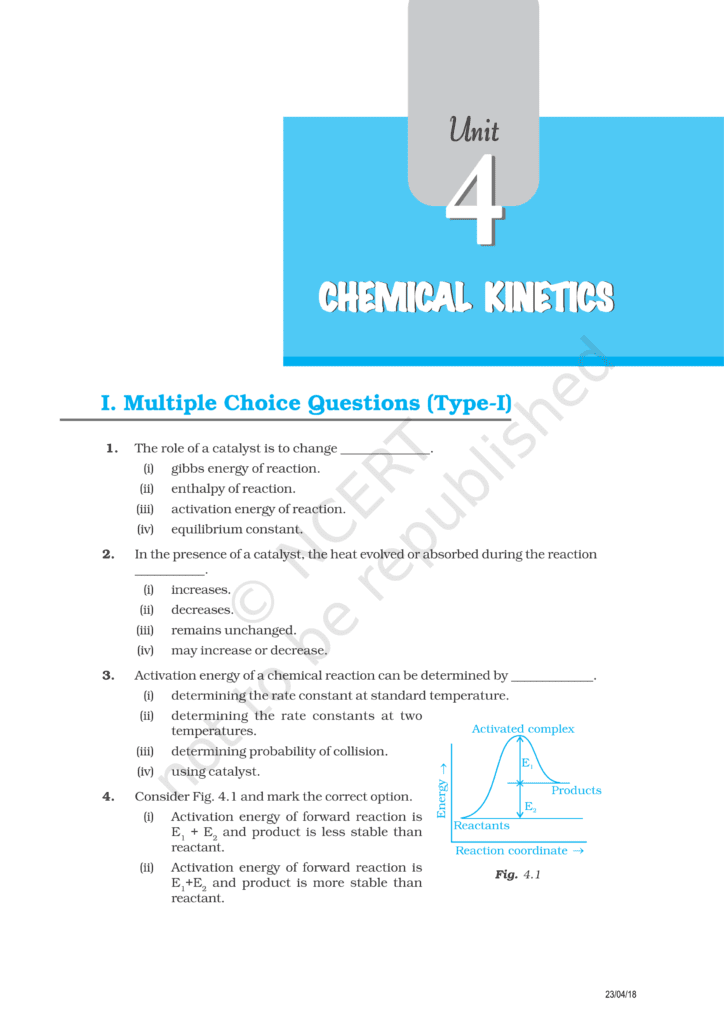Chapter 4 of Class 12 Chemistry, Chemical Kinetics, focuses on the study of reaction rates and the factors influencing them. The chapter begins by defining the rate of a chemical reaction, which measures how quickly the concentration of reactants or products changes over time. It then introduces the concept of rate laws, which express the relationship between the rate of a reaction and the concentration of its reactants. The chapter also covers the order of a reaction, which indicates the power to which the concentration of a reactant is raised in the rate law.
Students learn about different methods to determine the order of a reaction, such as the method of initial rates and the integrated rate law method. The concept of half-life is also explained, particularly for first-order reactions. Another key topic is the effect of temperature on reaction rates, described by the Arrhenius equation, which relates the rate constant to temperature and activation energy. The chapter also introduces the concept of molecularity, which refers to the number of molecules involved in an elementary reaction.
Furthermore, the chapter discusses catalysts and their role in increasing the rate of a reaction by lowering the activation energy. The difference between homogeneous and heterogeneous catalysis is also covered. Overall, this chapter provides a comprehensive understanding of how chemical reactions proceed over time and the various factors that can influence these processes.

Class 12th chemistry Chapter 4 Chemical Kinetics Books 📚 PDF download
👇👇👇👇
Short Answer Questions
What is the rate of reaction?
Answer: The rate of a reaction is defined as the change in concentration of reactants or products per unit time.
Define the order of a reaction.
Answer: The order of a reaction is the sum of the powers of the concentration terms in the rate law expression.
What is the molecularity of a reaction?
Answer: Molecularity of a reaction refers to the number of reactant molecules that participate in an elementary step of a reaction. It can be unimolecular, bimolecular, or trimolecular.
Explain the difference between molecularity and order of reaction.
Answer: Molecularity is the number of molecules participating in a single step of a reaction, whereas order is the sum of the exponents of the concentration terms in the rate law. Molecularity is always a whole number, while order can be a fraction.
What is the rate constant?
Answer: The rate constant, (k), is a proportionality constant in the rate law equation that relates the rate of a reaction to the concentrations of reactants. It is specific to a particular reaction at a given temperature.
Define half-life of a reaction.
Answer: The half-life of a reaction, (t_{1/2}), is the time required for the concentration of a reactant to decrease to half of its initial value.
What is the effect of temperature on the rate of reaction?
Answer: The rate of reaction typically increases with an increase in temperature due to an increase in the number of effective collisions between reactant molecules. According to the Arrhenius equation, as temperature increases, the rate constant (k) increases.
Long Answer Questions
Discuss the collision theory of reaction rates.
Answer: Collision theory states that for a reaction to occur, reactant molecules must collide with sufficient energy (equal to or greater than the activation energy) and with the correct orientation. The rate of reaction is proportional to the number of effective collisions.
What is the difference between elementary and complex reactions?
Answer: Elementary reactions occur in a single step with a single transition state, while complex reactions involve multiple steps, each with its own transition state. The molecularity is defined only for elementary reactions, while the overall reaction order is determined from experimental data.
What is the significance of the rate-determining step in a complex reaction?
Answer: The rate-determining step is the slowest step in a complex reaction mechanism and controls the overall reaction rate. The rate law for the reaction is usually derived from this step.
Discuss the effect of a catalyst on the rate of a reaction.
Answer: A catalyst increases the rate of a reaction by providing an alternative reaction pathway with a lower activation energy (E_a). It does not alter the equilibrium position but only speeds up the approach to equilibrium.
What is the significance of the frequency factor in the Arrhenius equation?
Answer: The frequency factor (A) in the Arrhenius equation represents the number of times that reactants approach the activation energy barrier per unit time. It reflects the frequency of collisions and the probability of a successful reaction.
Class 12 chemistry chapter 4 Chemical Kinetics Handwritten notes PDF download
👇👇👇👇

Get involved!
Comments